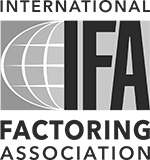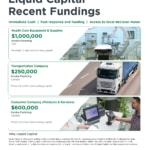Trust as Strategy: Turning Payment Terms Into Unbeatable Competitive Advantage
The Gift Only Small Businesses Can Give
Every small business owner knows the challenge of competing against companies with deeper pockets, bigger marketing budgets, and established brand recognition. In a world where size confers advantage, how can a smaller business not just survive, but actually outmaneuver the competition?
The answer lies in recognizing what you can offer that they cannot: agility, personal service, and perhaps most importantly, the strategic use of payment terms as a competitive weapon. Through invoice factoring, small businesses can transform what appears to be a disadvantage into their greatest strength.
“When you’re smaller, you have to be smarter,” explains Rebecca Perren, co-founder of Pehr Designs. After using factoring to build relationships with major retailers, her company achieved 5X sales growth. “Having seen how well it worked for us, I think businesses should take advantage of factoring when they don’t yet qualify for bank financing. It’s easy, efficient, and it really helped our business grow.”
When Bigger Isn’t Better
Large corporations struggle with the very size that gives them market presence. Their payment processes are bureaucratic, involving multiple approval layers and rigid payment schedules that prioritize consistency over customer relationships.
This creates opportunity for smaller businesses that understand a fundamental truth that in B2B relationships, cash flow challenges affect everyone. Your customers and prospects all share the same constraint that you do: they need better cash flow management.
While your competitors are often constrained by corporate payment policies that demand Net 15 or even payment on delivery, you can offer Net 60, Net 90, or even longer terms that actually help your customers’ businesses succeed. This isn’t just about being accommodating. It’s about giving your business a compelling point of difference.
The Trust Advantage
When you offer extended payment terms, you’re giving your customers something far more valuable than a discount: you’re giving them trust. Credit is an expression of confidence. When you tell a customer “I trust you to pay me in 90 days for what I’m delivering today,” you’re saying “I believe in you and what you’re doing.”
This gesture builds the foundation for profitable, long-term business relationships. It signals that you see your customers as partners, not just transactions. You understand their challenges because you’ve faced similar ones yourself.
Consider the psychological impact. When a large corporation demands payment on delivery, they’re essentially saying “We don’t know you well enough to trust you.” When you offer generous payment terms, you’re communicating “We’re confident in your success and want to support it.”
Research in trade credit demonstrates that these relationships create “mutual commitment and trust between the receiver and provider, forming closer and stronger” business bonds. Extended payment terms don’t just ease cash flow … they build competitive moats around your customer relationships.
Strategic Payment Terms in Action
Compare:
The Standard Corporate Approach
- Net 10 or payment on delivery
- “This is company policy”
- No exceptions for customer circumstances
- Payment terms used to minimize risk
The Small Business Strategic Approach
- Net 60 to Net 90+ terms available
- “Let’s find terms that work for your business”
- Flexible arrangements based on relationship strength
- Payment terms used to build customer loyalty
Summit Retail Solutions exemplifies this strategic approach. By factoring $3 million over 65 transactions, they built the capacity to offer terms that larger competitors couldn’t match. “With Liquid Capital’s help, we solidified our company through growth to maturity,” explains co-founder Ted Hope. “Teaming with Liquid Capital was the best thing our company could have done to allow us to grow and prosper.”
Their sales more than doubled from $1.4 million to over $4 million in 18 months … not because they had a better product, but because they could offer better terms than competitors who were constrained by traditional financing.
The Early Payment Discount Multiplier
Even though offering extended terms builds loyalty, you can also use the reverse strategy to accelerate cash flow and create win-win scenarios. By offering early payment discounts (such as 2/10 Net 60: a 2% discount if paid within 10 days, otherwise Net 60), you give customers choices that larger competitors often can’t match.
Corporate accounting departments typically lack the flexibility to take advantage of early payment discounts, even when the math clearly favors it. A 2% discount for paying 50 days early represents an annualized return of roughly 15%, a deal most finance managers would love to take, but corporate payment systems often can’t accommodate.
Your small business, powered by factoring, can offer these opportunities while still maintaining positive cash flow. When customers take the early payment discount, you get faster payment. When they don’t, you’ve still differentiated yourself through superior terms.
Best Broadcast discovered this advantage when CEO Dave Kip realized that “if other companies are offering early payment discounts, then you should consider factoring as a real option. I had always assumed that it would cost much more, but when looking at the calculations, invoice factoring was a much cheaper option.”
Breaking the Credit Constraint
Companies face internal constraints that prevent them from using payment terms strategically:
Budget Cycle Rigidity: Corporate financial planning operates on rigid cycles. Changing payment terms requires approvals that can take months.
Risk Management Focus: Many companies have departments dedicated to minimizing risk, which translates to shorter payment terms and stricter credit requirements.
System Limitations: Enterprise systems are often configured for standard terms and lack flexibility for customer-specific arrangements.
Small businesses, particularly those using factoring strategically, can move around these constraints with speed and flexibility that competitors simply cannot match.
The Factoring-powered Payment Strategy
Invoice factoring transforms payment terms from a cash flow constraint into a competitive weapon. Instead of being limited by your bank balance, you can offer terms based on what will win and retain customers.
Without Factoring: You’re constrained by your cash conversion cycle. If you offer Net 60 terms, you must wait 60 days for payment while still covering payroll, supplies, and overhead. This limits your ability to offer competitive terms.
With Strategic Factoring: You can offer Net 60 or Net 90 terms while accessing cash within 24-48 hours. Your customer gets the extended terms they need; you get the cash flow to operate and grow.
This isn’t about covering emergency cash flow gaps: it’s about creating sustainable competitive advantages through superior customer terms.
How to Get Started
- Competitive Term Analysis: Research what payment terms your competitors offer. Most corporate websites publish standard terms in their vendor information. Identify opportunities to offer more attractive alternatives.
- Customer Segmentation: Identify which customers would benefit most from extended terms. Growing companies, seasonal businesses, and customers facing cash flow challenges are prime candidates.
- Term Flexibility as Value Proposition: Build payment term flexibility into your sales presentations. Instead of leading with price or features, lead with “How can we structure payment terms that work for your business?”
- Early Payment Incentives: Offer discounts for early payment (2/10 Net 60) to create win-win scenarios. Customers who can pay early get savings; those who can’t get extended terms.
- Strategic Account Development: Use generous payment terms to build relationships with strategic accounts that competitors might overlook due to size or credit constraints.
Measuring Competitive Advantage
Track how payment terms impact your competitive position. Monitor win rates when payment terms are part of evaluation criteria. Extended terms typically improve customer retention as switching costs increase. Customers with better payment terms often place larger orders since cash flow isn’t constraining purchases. Relationships built on trust and favorable terms typically generate higher lifetime value than purely transactional relationships.
Building Lasting Competitive Moats
The most powerful aspect of this strategy is that once customers experience superior payment terms, they become reluctant to switch to competitors offering less favorable arrangements. You’ve created switching costs that go beyond product features or pricing.
SiSTEM Tutoring discovered this when working with school districts that required Net 30 terms. By using factoring to accommodate these payment schedules while maintaining weekly payroll for tutors, they built competitive advantages that larger tutoring companies, constrained by traditional cash flow management, couldn’t match.
“We just felt like we didn’t really need a loan per se. We just needed quick access to the money that we’ve earned through our services,” explains founder Pearl Ubaru. This understanding allowed SiSTEM to offer payment flexibility that supported both their customers’ budget cycles and their own operational requirements.
The Trust Multiplier Effect
Extended payment terms signal partnership. When you offer a customer Net 90 terms, you’re communicating investment in their success, not just the immediate transaction. This builds relationship equity that compounds over time.
Customers begin to see you as a business partner who understands their challenges rather than just another vendor demanding quick payment. This psychological shift often leads to earlier involvement in planning processes, preference when multiple vendors are considered, referrals to other potential customers, larger orders due to improved cash flow confidence, and longer-term contracts.
From Payment Terms to Competitive Strategy
Strategic use of payment terms represents a broader competitive philosophy: using your size and agility as advantages rather than seeing them as limitations. While larger competitors are constrained by corporate policies and shareholder demands for quick cash conversion, small businesses can build customer relationships through financial partnership.
This approach works because it addresses a universal business need. Every business, regardless of size or success, faces cash flow management challenges. By offering solutions to your customers’ cash flow constraints, you’re not just selling products or services. You’re solving business problems.
The companies that thrive in competitive markets are those that understand this principle: competitive advantage often comes not from what you sell, but from how you sell it. Payment terms, powered by strategic factoring, give small businesses a way to compete not on size or resources, but on customer value and relationship building.
Getting Started with Strategic Payment Terms
If you’re ready to transform payment terms from a constraint into a competitive advantage:
- Analyze your competitive landscape: Research standard payment terms offered by your competitors and identify opportunities to differentiate.
- Identify strategic customers: Focus on growing companies, seasonal businesses, or those in industries known for cash flow challenges.
- Calculate the competitive advantage: Model how different payment terms would impact both your cash flow (with factoring) and your customers’ operations.
- Develop your payment term strategy: Create a framework for offering different terms based on customer relationship, order size, and strategic value.
- Partner with a factoring company: Choose a factoring partner who understands your strategic approach and can support flexible payment terms without constraining customer relationships.
Your Competitive Edge Awaits
The businesses that succeed in competitive markets find ways to offer unique value. Where product and service features and pricing become rapidly commoditized, the companies that win solve intangible problems their competitors cannot.
Payment terms, strategically deployed through factoring, give you the ability to offer something competitors cannot: trust, flexibility, and partnership. You can give your customers the gift of improved cash flow while building the loyal relationships that sustain long-term business success.
Your size isn’t your limitation: it’s your competitive advantage waiting to be unlocked.
Continue Your Factoring Education
This article is the eighth installment in our 2025 Strategic Factoring Series. If you found this strategic approach valuable, explore our previous articles to develop a comprehensive understanding of how factoring can fuel your business growth:
- January 2025: Say “Yes” to Larger Orders – How invoice factoring enables you to take on bigger opportunities without cash flow stress
- February 2025: Time Your Growth – Using factoring to capitalize on seasonal demand and opportunities
- March 2025: The Early Payment Advantage – Leveraging factoring to capture supplier discounts and lower your costs
- April 2025: Smart Equipment Investment – How factoring your receivables can fund growth without adding debt
- May 2025: Building Your A-Team – Using steady cash flow from factoring to hire and retain top talent
- June 2025: The Multi-Contract Strategy – Managing multiple large projects successfully with invoice factoring
- July 2025: Beyond Survival Mode – How changing your mindset transforms your business












